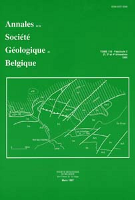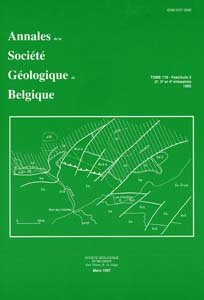- Accueil
- Volume 93 (1970)
- Fascicule 3
- Microtextures of Fe-Ti oxide minerals in the South-Rogaland anorthositic complex (Norway)
Visualisation(s): 345 (0 ULiège)
Téléchargement(s): 400 (2 ULiège)
Microtextures of Fe-Ti oxide minerals in the South-Rogaland anorthositic complex (Norway)

Résumé
Les microstructures de l'ilménite et de la magnétite sont étudiées dans les roches du complexe anorthositique du Rogaland méridional (Norvège méridionale).
Les microstructures de l'ilménite résultent d'un simple processus de démixtion de la solution solide ilménite-hématite. Les lentilles d'hématite apparaissent seulement pour des teneurs en hématite supérieures à 7-9 % mol Hém. La magnétite contient des intercroissances d'ilménite disposées selon deux types extrêmes de microstructure : la microstructure en tissu et la microstructure en treillis (et sa variante en sandwich). Les deux types peuvent coexister dans un même grain. Cette ilménite est formée par oxydation d'ulvöspinelle initialement en solution solide dans la magnétite, cette oxydation commençant à des températures supérieures ou inférieures à celles du solvus magnétite-ulvöspinelle. L'hypothèse de l'existence d'une solution solide γ-FeTiO3-Fe3O4 est discutée et rejetée.
L'ilménite primaire, lorsqu'elle est en contact avec un grain de magnétite, montre à proximité du contact un zonage de son contenu en hématite. Un cordon d'ilménite spinellifère, en continuité optique avec l'ilménite primaire voisine, est également présent au contact. Cette ilménite secondaire est produite par oxydation d'ulvöspinelle présent dans la magnétite. Cordon et zonage indiquent qu'une réaction subsolidus intervient quand les deux oxydes sont en contact et provoque une réadaptation deutérique de leur composition orthomagmatique. Ce phénomène doit être pris en considération dans l'utilisation des valeurs de la température et de la fugacité de l'oxygène déduites des travaux de Buddington et Lindsley.
Abstract
Ilmenite and magnetite in anorthositic and related rocks (South-Rogaland igneous complex — S.W. Norway) are investigated from the point of view of their micro-textures.
The microtextures of the ilmenite result from simple exsolution of ilmenite-hematite solid solutions. Hematite lenses appear when the hematite content is higher than 7 to 9 mole percent Hem. Magnetite contains intergrowths of ilmenite according to two extreme types of microtexture: the cloth microtexture and the trellis microtexture (including its sandwich variant). Both types may coexist in the same grain. This ilmenite is formed by oxidation of ulvöspinel, initially contained in the magnetite, at temperatures above or below the solvus magnetite-ulvöspinel. Arguments leading to rejection of the γ-FeTiO3-Fe3O4 solid solution hypothesis are given.
Primary ilmenite adjacent to a magnetite grain shows a zonal variation of hematite content. A rim of spinelliferous secondary ilmenite, in optical continuity with the neighbouring primary ilmenite grain, is also observed at the contact. It is shown that this secondary ilmenite is also produced by oxidation of ulvöspinel initially contained in the magnetite. Rim and zoning at the contact between ilmenite and magnetite indicate that a subsolidus reaction has brought about a deuteric readjustment of the initial orthomagmatic compositions. This phenomenon has to be taken into account when applying the geothermometer and oxygen fugacity barometer of Buddington and Lindsley.






